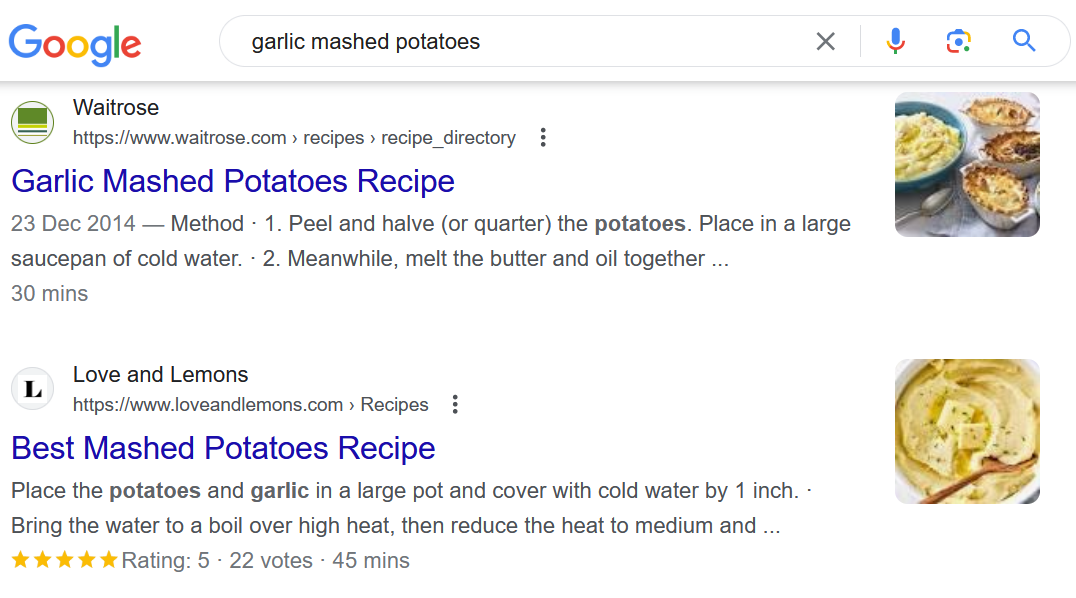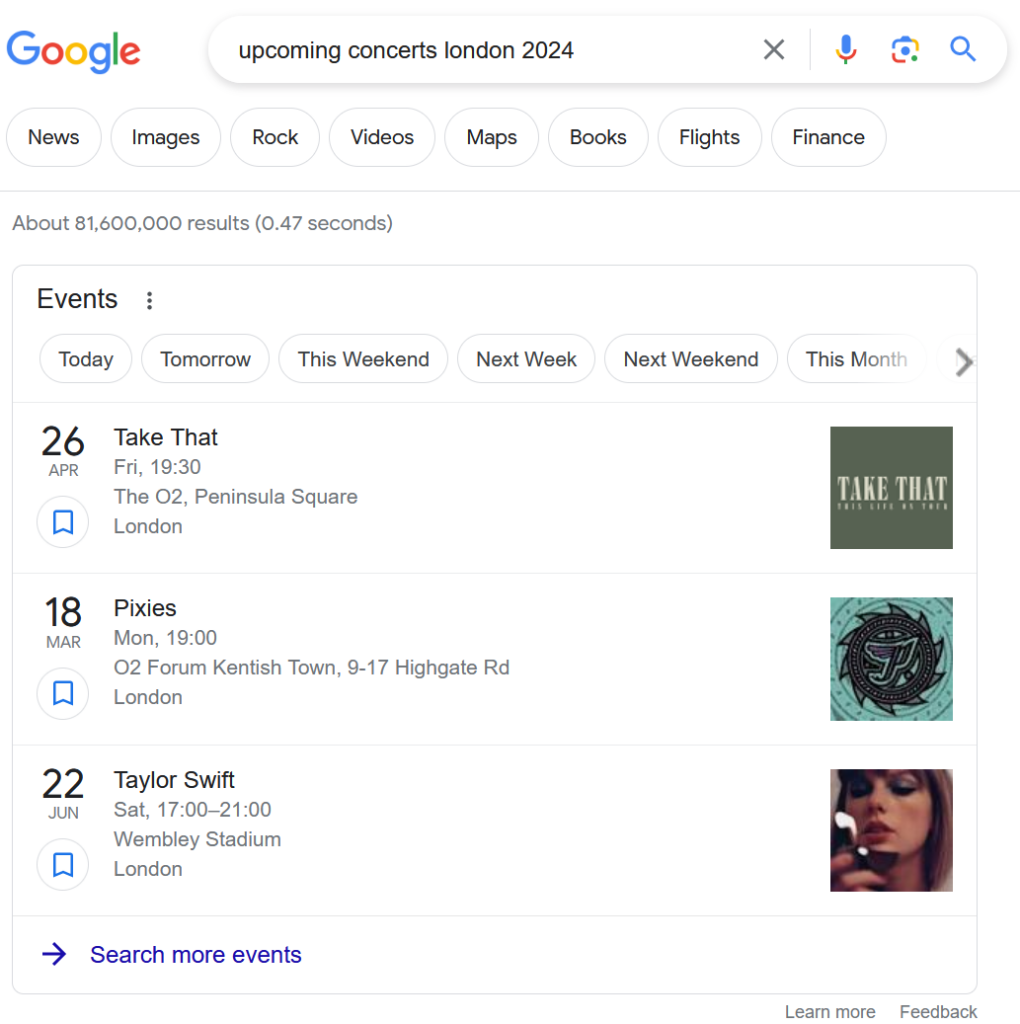When you’re going on a date or attending a job interview, you want to present the best version of yourself. You don’t rock up in a crinkled shirt with hair that hasn’t seen a brush in days. You choose your most suitable outfit, style your hair, and shine your shoes.
This is the difference between a search engine result without a rich snippet, and a search engine result without one.
With a rich snippet, your results show themselves in their best possible light.
This can increase click-through rate, and also get your site ranking higher on Google. Are your website results ready to get glammed up? Here’s how.
Rich Snippets Explained
A rich snippet is also sometimes known as rich results.
The two terms are interchangeable. Rich snippets feature in regular search engine results as additional information.
While regular search engine results include the site’s URL, meta title and description, with rich results users will see all of these things plus additional information chosen by you, such as:
- product availability
- delivery times
- star ratings
- upcoming events
Do Rich Snippets Help SEO?
Rich snippets make your search engine results more attractive to the user.

The first result shown here has no rich snippet, while the second result has a star rating, votes, and an indication of how long the recipe takes.
Despite being further down the page in terms of rankings, the second result is likely to get more click-throughs because it has rich results.
But can they actually improve your ranking?
Some arguments suggest they can.
Rich snippets are achieved using structured data, which helps search engines to gain a better understanding of web pages. When search engines understand a web page, they are more likely to consider it as a good option to provide in response to relevant user queries in search results.
Examples of Rich Snippets
There are many different types of rich snippets, all of which give the user more information about your website. Depending on what type of website you have, or the content on your page, the type you select will differ.
Rich Snippets for Products

For product pages, rich snippets typically include the product price, its availability, delivery information, ratings, and an image.
All of these additional pieces of information provide the user with the insight they need to know whether it’s worth clicking on the link, helping your site get more traffic.
The rich snippet on this product example reveals the product price, a star rating, stock information, and an image.
Rich Snippets for Recipes

Recipe pages can be marked up for rich snippets, which can show recipe ratings, reviews, duration, and calories.
Rich Snippets for Events

Rich snippets for events can include various information such as event dates, times, and locations.
They might also include an image to draw further attention to the search result and make it more visually appealing to users.
How to Get Rich Snippets
Are you ready for your website’s search results to have a makeover? Follow these steps:
Structured Data Markup
The first step in getting rich snippets is to markup your data. You can do this using Google’s Structured Data Markup Helper, which makes it easy to markup your site without having to understand code.
- Enter Your URL. Enter the URL of the page you want to markup in the provided field. If your website is not publicly available, you can paste your existing HTML code directly into the box.
- Run Test. Click the ‘Run Test’ button. The tool will analyse your HTML code.
- Check Results. The tool will display any structured data it finds on your page. If there are errors or warnings, they will be listed along with suggestions for improvement.
- Add Markup. Click on the ‘Add Missing’ link next to the suggested type of markup and choose your data type. For example, for a recipe page, you might use the ‘Recipe’ type.
- Fill in Prompts. You will now have the option of marking up various parts of your content. For a recipe, you could markup the recipe title, the recipe ingredients, the recipe instructions, the recipe rating, recipe calories, recipe reviews, and recipe duration.
- Create HTML. When you’ve finished marking up your data, click the ‘Create HTML’ button, which can be found in the top right corner of the window. The tool will generate the HTML markup for you.
- Insert HTML. Copy the generated HTML markup, ready to be pasted to the relevant section of your page. Commonly, it will be inserted into the section of the HTML, or it can be placed within the body of the page.
Rich Results Test
Now your data has been marked up, you need to check that it’s worked correctly to create rich snippets in your search results.
You can use Google’s Rich Results Testing tool to do this.
Visit the testing tool website and enter your page URL into the search bar. Now click the ‘Test URL’ button. After a minute or two, the tool will present its results. The ‘Detected Structured Data’ section will show you what structured data was detected. If any fields are missing or invalid, this will be indicated with suggestions on how to fix them.
Google on Rich Snippets
Frustratingly, using structured data markup cannot guarantee that your website search results will feature a rich snippet, it simply enables it.
Google states: “Using structured data enables a feature to be present, it does not guarantee that it will be present. The Google algorithm tailors search results to create what it thinks is the best search experience for a user, depending on many variables, including search history, location, and device type.”
That being said, structured data markup is always worth doing. It can help SEO in a number of ways, and certainly won’t cause any harm.
Final Words
It doesn’t take a lot of time to make your website compatible with rich snippets.
Bearing this in mind, it’s certainly worthwhile since having them in SERPs can increase your click-through rate. If a search engine doesn’t display it, you haven’t lost anything. With rich snippets, there’s everything to gain and nothing to lose.
Need help figuring out how to get rich snippets for your website, or want someone to take the task off your hands? Contact us for more information.
- Canonicalization: The Dos and Don’ts of Canonical Tags - May 27, 2024
- On-Page SEO: The Ultimate Guide - May 25, 2024
- The Only WooCommerce SEO Tutorial You Need in 2024 - May 23, 2024